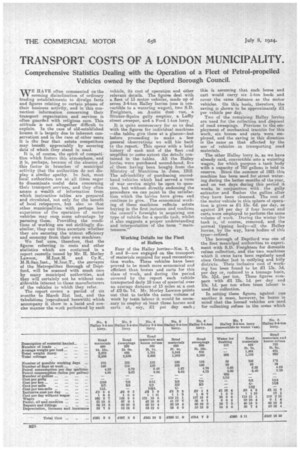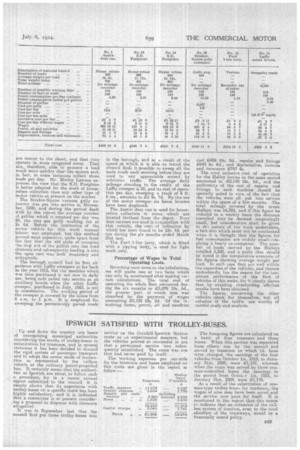TRANSPORT COSTS OF A LONDON MUNICIPALITY.
Page 14

Page 15

If you've noticed an error in this article please click here to report it so we can fix it.
Comprehensive Statistics Dealing with the Operation of a Fleet of Petrol-propelled Vehicles owned by the Deptford Borough Council.
WE HAVE often commented on the seeming disinclination of ordinary trading establishments to divulge facts and figures relating to certain phases of their business activity, and in this connection information concerning their transport organization and services is often guarded with religious care. This attitude is not altogether difficult to explain. In the case of old-established houses it is largely due to inherent conservatism and in the case of other users it is the fear that astute competitors may benefit appreciably by securing data of which they stand in need.
It is, of course, the spirit of competition which fosters this atmosphere, and ft is, perhaps, because of the absence of this factor in branches of municipal activity that the authorities do not display a similar apathy. In fact, most local authorities are at all times eager to disseminate useful data concerning their transport services, and they often amass a wealth of information from which instructive tables are. prepared and circulated, not only for the benefit of local ratepayers, but also so that other municipalities with perhaps less experience of the operation of motor vehicles may reap some advantage by perusing them: Providing the conditions of working are not strikingly dissimilar, they can thus ascertain whether they are securing the utmost efficiency and economy from their own machines.
We feel sure, therefore, that the figuree referring to costs and other statistics which are contained in a report recently issued by Mr. H. Morley Lawson M.Inst.M. and Cy.E., M.R.San.Intst., M.Inst.T., the surveyor of the Metropolitan Borough of Deptford, will be scanned with much care by many municipal authorities, and they will certainly not be without considerable interest to those manufacturers of the vehicles to which they refer. The report covers a period of six months to March 31st last, and the tabulations 'reproduced herewith) which accompany it show in a lucid and concise manner the work performed by each vehicle, its cost of operation and other relevant details. The figures deal with a fleet of 13 motor vehicles, made up of seven 3-4-ton Halley lorries (one is convertible to a watering wagon), two S.D. Freighters, an Austin dust van, a Straker-Squire gully emptier, a Lally street sweeper, and a Ford 1-ton lorry.
It is quite unnecessary for us to deal with the figures for individual machines -the tables give them at a glance-but before proceeding to make a few general observations we will his back to the report. This opens with a brief history of each unit of the fleet iid amplifies to some extent the details contained in the tables. All the Halley lorries were purchased second-hand, five of them having been bought from the Ministry of Munitions in June, 1919. The advisability of purchasing secondhand vehicles which had served a term of war service might be open to question, but without directly endorsing the procedure we can point to the satisfaction which the lorries have given and continue to give.. The economical working of these machines reflects astute buying in the first instance and confirms the council's foresight in acquiring one type of vehicle for a specific task, whilst it also suggests a proper underetandiug and interpretation of the term "maintenance.'
Working Details.for the Fleet of lialleys.
Four of the Halley lorries-Nos. 2, 4, 5 and 8-are engaged on the transport of materials required for road reconstruction works. These vehicles have been proved to be much more economical and efficient than horses and carts for this class of work, and during the period covered by the report each vehicle transported daily 18 tons of material over an average distance of 15 miles at a cost of 22 Os. 7d. Mr. Morley Lawson points out that to tackle the same volume of work by team labour it would be necessary to employ at least three horses and carts at, say, 21 per day each;
this is assuming that each horse and cart would carry six 1-ton loads and cover the same distance as the motor vehicles. On this basis, therefore, the saving is shown to be approximately 21 per vehicle per day.
Two of the remaining Halley lorries are used for the collection and disposal of road sweepings. Previous to the employment of mechanical traction for this work, six horses and carts were employed, and the saving in this direction is the same as that effected by the use of vehicles in transporting road materials.
The other Halley lorry is, as we have already said, convertible into a watering wagon, for which purpose a tank body with a capacity of 750 gallons is held in reserve. Since the summer of 1921 this machine has been used for street watering during the better months of the year, and on wet days during this period it works in conjunction with . the gully extractor and flushes the gullies alter they have been cleansed. The cost of the motor vehicle in this sphere of opera-tion is given as 21 13e. 6d. per day, as against 24 per day if four horses and carts were employed to perform the same volume of work. During the winter the tank is, of course,, removed, and the normal tipping body-all the Halley lorries, by the way, 'have bodies of this type-refixed.
The borough of Deptford was one of the first municipal authorities to experiment with S.D. Freighters for domestic refuse collection, and the two machines which it owns have been regularly used since October last in outlying and hilly districts. Their inclusive cost of working' has been found to be 21 13s. 3d. per day or, reduced to a tonnage basis, 10s. 31c1. per ton. These figures compare with LI 12s. id. per day and 10s. Id. per ton when team labour is used for collection.
In setting these figures against one another it must, however, be borne in mind that the horsed vehicles are used for collecting refuse in the areas which
are neater to the shoot, and that they operate in more congested areas. They are, therefore, able, to procure a load much more quickly thee the motors and, in fact, in some instances collect three loads per day. Mr. Morley Lawson expresses the view that the S.D. Freighter is better adapted for the work of houseref use collection than any other type of motor vehicle at present on the market. The Straker-Squire vacuum gully extractor was put into service in November, 1920, and during the period dealt with by the report the average number of gullies which it emptied per day was 29, the cost per gully working out at 2s. fid. Before the institution of the motor vehicle for this work manual labour was employed, but this method proved 'meet expensive, quite apart from the fact that the old style of scooping -.he slop oet of the gullies into the road channels and subsequently loading it into the open cart was both insanitary and un hygien ic.
The borough council had its first et. Perience with Laffly sweepers so far lack as the year 1915, but the machine which was then purchased is not now in ,daily use, being only called into service. as an auxiliary broom when the other Laffly sweeper, purchased in July, 1923, is not in commission. The working period of the sweeper is covered by the hours from 6 a.m. to 1 p.m. It es employed for aweeping the permaneatly paved roads
in the borough, and as a result of the speed at which it is able to travel the council finds it possible to sweep all the main roads each morning before they are tired to any appreciable extent by vehicular traffic. The average daily mileage standing to the credit of the Laffiy sweeper is 28, and its cost of operation per day, sweeping a track of 6 ft. 6 ins., amounts to £1 9s. 7d. By the use of the motor sweeper six horse brooms have been displaced. The Austin dust van is used for houserefuse collection in areas which are located farthest from the depot Four dust carriers ate used in cenjunction with this vehicle, the cost of collection by which has been found to be 12s. 4d. per ton during the six months ended Marcia 31st last.
The Ford 1-ton lorry, which is fitted with a tipping body, is used for light work only.
Percentage of Wages to Total • Operating Costs,
Reverting once more to the tabulations, we will quote one or two facts which can only be ascertained after making eer, . thin calculations. The total cost of operating the whole fleet. amounted during the six months to £3,979 19s., 5d., the greater part. of which sum was absorbed by the payment of wages amounting £2,132 19s. 2d. Of the remaining items, petrol, oil and eundries
cost £429 10s. 9d., repairs and fittings £643 5s. 6d., and depreciation, licences and insurance £747 4s.
The total inclusive cost of operation for the Halley lorries in the same period amounted to £2,149 18s. 5d., and the uniformity of the cost of repairs ;Ind fittings to each machine should he specially noted in view of the fact that the vehicles were all pat into service within the space of a few months. The total mileage covered by the seven Halleys was 14,319, and if this figure be reduced to a weekly basis the distance travelled may be deemed surprisingly small, but consideration must be given to the nature of the work undertaken, a fact also which must. not be overlooked whoa it is thought that the figures for fuel consumption are unduly small—implying a heavy co reumption. The number of loads carried by the Halleys totalled 3,593, and a point that should be noted is the comparative evenness of the figures showing average weight per load. Ii' each case they are well within the capacities of the vehicles, and therein undoubtedly lies the reason for the consistent performance of the fleet of vehicles of this make, for it clearly shows that by avoiding overloading efficient results have been obtained.
The figures concerning the other vehicles speak for themselves, but all columns of the tabiss are worthy of careful study and analysis.






























